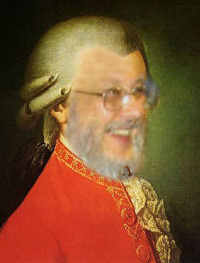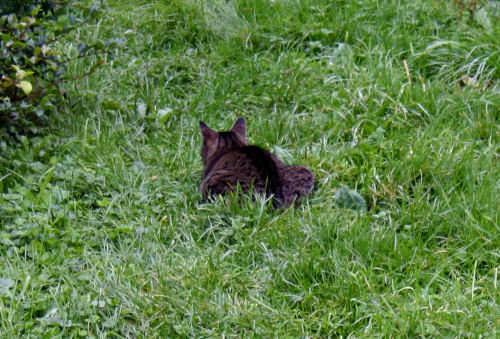A 365-Day Project
"We Are All Mozart"
A project to create
new works and change
the perception of the
music of our time.


 September 15, 2006
September 15, 2006 
George Dyson was a British composer (1883-1964) whose life was synchronous with Zoltán Kodaly, Igor Stravinsky, and Arnold Schoenberg -- none of whom he mentions in his 1932 book, The Progress of Music.*
Sir George came to my attention when I was researching the idea of progress with respect to music. If he sounds familiar, it's probably not for his music or books, but because the Dyson name is associated with his more famous son, physicist and mathematician Freeman Dyson (made famous by Star Trek's (mis)use of the Dyson Sphere), and Freeman's children, scientific historian George and futurist philospher Esther.
If I had expected Dyson would actually be speaking of musical change up to and through his own time, the anticipation was not met. He explores the relationship of music and society largely into his coming of age in the late 19th century. But the very modern use of 'progress' -- the word that fit the book's contemporaneous art deco Empire State Building (1930-1) and the streamliner Burlington Zephyr (1932-4) -- is lost in Dyson's approach. His book is an examination of five broad musical venues and their impact on the change in European music, and those venues are the titles of the chapters: "The Church," "Castle and Chamber," "The Stage," "The Concert-Hall" and "Men and Machines."
The Progress of Music is by no means a rigorous history, and without a reader's existing fairly comprehensive knowledge of music and history, the book would survive largely on its anecdotes. (I also learned that my own postmodern impatience is showing, as a book without media content -- images and audio -- has become a struggle to keep my attention.) In "The Church," Dyson posits that the church -- the building, the institution, the religion, the mores -- was the center of every European village. "They enshrine for us the major part of what our ancestors meant by civilization, by corporate devotion, and by the triumph of mind over matter," he wrote. His contrast is with his modern towns, "which usually begin with a railway-station" -- a place of arrival and departure. Where once saints and sinners, peddlers and actors, counsellors and musicians gathered together in the single center of existence, now each of us is dispatched to buildings with special purposes, whether a shop or theater or town hall or concert hall or the increasingly quiet and silent church.
His point is not that religion was the dominant force, but that everyone participated in building and using the church; it was simply the common currency of life's experience from birth to death. That a mason helped build it did not create a religious mason, and likewise, "no spiritual fervour will of itself teach a man even the beginnings of an art." (Dyson does trip over the notion of religion, dismissing by implication Judaism and Islam, as well as subsequent religious tenets that disavowed music in church.)
By building on the concept of the church, Dyson can explore the shared speech and constant association that gives rise to common, fixed chant ("an unsurpassed type of musical expression") as well as the creative restlessness that breaks inexorably away from the strictures of fixedness through slow trial-and-error. The slowness of this process is only apparent from temporal distance, for Dyson's inner composer makes the point that even the composer working within strong traditions will find new versions of old truths. He points out the inherent composer's limitation, that "every age writes up to the limits of its vision."
Carrying the early music rapidly forward to the Reformation, Dyson makes clear his deep belief in harmony and that surviving hymn tunes represent, though their writing and selective filtering over time, a 'democratic' art. This democracy is certainly to be preferred to, for example, the Council of Trent and its top-down musical decision-making -- and he finds his example in, of all people, J. S. Bach. For Dyson, Bach's musical conservatism makes him the ideal vessel for the alchemical synthesis of extant ideas into compositions that perfectly fit the church aesthetic "as a profession of faith and as the practice of an art."
And there it ends, Dyson believes, because no significant religious music has been composed since. The religious works of late Bach, Mozart, Beethoven, Schubert, and onward through Verdi were concert music, comfortable in the church or concert hall, but not integrated with religious purposes. He writes, "The Church borrows from these masterpieces. She no longer creates them." The first chapter stutters to a close with some discussion of organs and instruments.
A more difficult task is set out with "Castle and Chamber," because Dyson depends on assumptions about the nature of secular music -- slave songs, lullabyes, and sea chanteys -- and makes evident a classism uncomfortable to 21st century discourse. His conclusions about the role of nature and artifice have a longing and pastoral feel, as he has at hand limited sources beyond occasional poetic descriptions from Chaucer and Shakespeare. And so he turns at last to musical content (which has up to this point been spare) to discuss the character of madrigals, and their place in the cultivated households of the late continental Renaissance and Tudor England.
Dyson crawls through the development of harmony and keyboards, and spends a good deal of time praising the contributions of his native England. Writing as he does from the birth of technological modernism, just after the Great Depression and teetering between two World Wars, Dyson finds riches in Purcell but dismisses François Couperin by saying, "within his small range he is incomparable." It seems that the Englishman has an ornery streak as well, for he gives significant attention to Johann Kuhnau, the progressive to Bach's conservative. Where Bach's music "was out of date before it was written," Kuhnau's sonatas "have hardly a parallel until we reach the symphonic poems of the nineteeth century."
In exploring the vocal techniques of European cultural centers and the particular contributions of Arcangelo Corelli, Dyson makes the case for the beginnings of virtuoso practice, and with it the dominance of Italian terminology and technique in music. Skittering quickly forward, Dyson picks up the middle class and its voracious need for new entertainment, coming to rest in his present when "our homes are being invaded by the machines" -- player pianos. Dyson is dismayed.
The Progress of Music follows separate, complementary paths. The third is "The Stage," wherein Dyson again founders among primitive peoples until moving as best he can through Greek drama, medieval pageant, morality plays, oratorio and opera, arriving at Wagner's music drama as the last evidence of musical stagecraft. (He deals with dance later in the chapter.) What Dyson misses because of his place in time is the American musical and sound film; indeed, he makes no mention whatsoever of silent film, which was accompanied for the decades preceding the book by keyboards, organs and chamber ensembles.
Dyson's handling of staged music is historical and dreary until he arrives at the slow birth of modern opera, which he introduces by writing, "the diseases of the stage are public diseases." He rough-and-tumbles his way through the world of theater boxes and gilt, and the rise of the singer as star, and courses through the European history of opera production, arriving at a statement startlingly appropriate for this project's search. Composers "are supposed to live in a world where the ordinary standards of social and commercial competence are unknown. [...] They are held to be the absolute negation of business ability. Nothing could well be further from the truth."
With evidence of both massiveness of production (with lions, elephants, horses, boar, deer and bears) to sheer quantity (Alessandro Scarlatti and Johann Hasse with more than 100 operas each), Dyson sees management and productivity as a hallmark of composition, and completes the case with Richard Wagner (this was just before the Third Reich polluted the conversation) and his determined rise from the ordinary middle-class to a cult not seen again until Stockhausen attempted to rebuild it after World War II.
(It's notable that Puccini, Mascagni, and Bartók, among many others, make no appearance in the opera section of Dyson's book, nor do Stravinsky or Milhaud, nor any shred of the Second Viennese School in the concert hall chapter.)
By the time Dyson comes to "The Concert-Hall," the progress of music -- book or topic -- is anticlimactic. He makes the effective point that in early halls, "the music was almost entirely contemporary, often written for the occasion," but Dyson falls largely into anecdote throughout the chapter, concentrating on personalities and events. Unaware that the original instrument movement would follow in a few decades, though, Dyson pronounces that, were we to hear original performances of Bach or Handel, we would be "struck by the general reediness and coarseness of tone, and the longer we listened the more distressing it would become."
More tomorrow.
*Found at The Internet Bookshop UK Ltd., £7.

Gesualdo crouches into invisibility, waiting for history to happen.